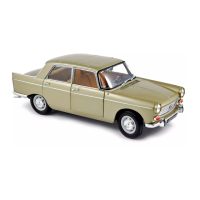I
I
I
i
I
mended
by the manufacturer are Esso A.AO.AFT.2974A
or
DEXRON
B 10696
and the total
capacity is 9.1
pints
(5.2
litres).
At the inteÍvals
laid
down in the Owners
Hand Book the
transmission
should be drained by
removing the
drain
plug
on
the rear face oí the oil
pan,
This
is
preferably
done
when warm, but care must be taken as
the f luid may be at
a very high temperature and
injury may be caused if
allowed to contact
the hands.
ReÍilling
is
best carried out by
first
pouring
in
3{
pints
(2
litres)
of
fluid, then start the engine and allow
it
to
idle while sufficient
Íluid
is added to bring
it
up
to the
MAXI mark on the diostick.
The manufacturers advise against any
adjustments of
the transmission or
its
controls and
in the event of
a
breakdown the car should be taken to an accredited
agent
for
attention or a new unit
Íitted. For those owners
who
feel
able to carry out this operation
for themselves,
instructions
on
the removal
of
the transmission are
given,
Removing
the transmission :
Disconnect the exhaust
pipe
and the speedometer
drive.
Unbolt the
propeller
shaft at the
back
of
the
trans-
mission and move the rear
axle
rearwards
as
Íor
the
removal of the manual
gearbox.
Disconnect the linkage
between the selector
lever
and
the operating lever on the transmission.
Disconnect
the
leads
to the inhibitor switch, noting
caref ully their
positions
for later reassembly.
Take the weight oÍ the engine
on a
suitable
garage
jack
and remove the
bolts securing the engine to the trans-
mission. Remove the oil Íiller
pipe
and cover
the hole
to
prevent
the entry
of any
foreign
matter.
Remove the
protecting
plate
under the converter, then
undo
the securing
screws
from
the converter
plate.
This
may be
done
through
the hole
in
the Ílywheel by turning
the crankshaft a little
at a
time.
Remove the crossmember
behind the transmission.
Move the
engine on
its
jack
as far forwards as the
Ílexible mountings will
allow and then
pull
out the trans-
mission unit towards the rear. Make
sure
that
the con-
verter assemblv remains with the transmission
and does
not move forwards with
the engine during this operation,
Refitting:
This is a
reversal
oÍ the removal
procedure
but be
particularly
caref ul oÍ the two centring tubes on the front
Íace of the converter housing.
6:10
Gear change controls
The steering column
gear
change
lever
assembly
is
shown
in FIG
6:37
and if it is to be overhauled it will
be
necessary first to remove the steering column. Be sure
to
mark the
position
of the lower, C shaped,
lever
on the
splines of the control
rod,
as
incorrect angular
refitting
will
seriously
affect its operation.
The dimension a
is imoortant
and
is determined as
follows:
On earlv
cars the centre to centre distance on the
C shaped
lower lever is
95
mm
and
on later cars it is
80
mm. Dimension a on the early type
must
be
18+2
mm
and on
the later type it is 22+2 mm.
The selector contÍols on the
gearbox
are shown
in
FIG
6:38 and
may or may not have a locking device
in
the neutral
position.
To
adjust the
first type:
Place the steering column selector
lever in 2nd
gear
and then slacken the
pin
nut 1.
Mark the
maximum
play positions permitted
by the
selector
lever
and
then
place
the selector lever in the
middle
position
and tighten selector
rod 2
by
tightening
the oin nut
1.
Check the
movement in
all
gears.
To adjust the
mechanism with the neutral locking
device oroceed as
follows:
Place the
gear
selector lever in neutral and slacken the
pin
nut
L
Ensure that the selector lever 3 is in the
neutral
ball
lock
position
and ad.iust as before.
6 :11 Fault diagnosis
(manual gearbox)
(a)
Jumping
out of
gear
1 Misalignment between transmission
and
clutch
housi
ng
2
Worn
shift detent
parts
3 Worn clutch shaÍt bearing
4 Worn teeth of
dog
clutch
5 lmproper
adjustment oÍ linkage
6 Worn main
shaít
bearings
7 Worn
countershaft
thrust washers
8 Excessive main shaft end
play
9
Worn
counter
gear
or counter
gear
bearings
(b)
Noisygearbox
1 lnsufficient lubrication
2
Worn or damaged
bearings
3
Excessive
end
play
in main
shaft
4 Worn
or damaged
gear
teeth
5
Speedometer
gears
worn
or damaged
(c)
Difficulty in
engaging
gears
1 Incorrect clutch
pedal
adjustment
2 Worn
synchromesh cones
(d)
Oil leaks
1 Damaged
joint
washers
2 Worn
or damaged oil seals
3
Transmission covers loose
or faces damaoed.
P404 63

